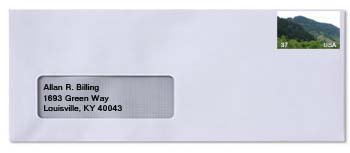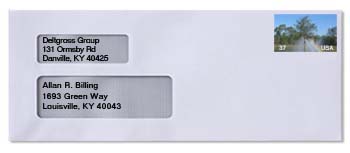Watch How Dixie Folds a Business Letter
Folding a Business Letter? Sure!
Do you think there's nothing to learn about folding a business letter? You could say that it should not be any different from folding any letter. And you might be just right, Dixie agrees.But you know, postal standards can differ ever so slightly from one country to another. Dixie has already shown you the difference between some of the US and European standards. Besides, some standards change with time. And the size of the envelope matters, of course.
Dixie Expertly Folds a Business Letter

Dixie Folds a Letter
To demonstrate folding a business letter Dixie uses the standard business envelope (Legal or #10 envelope in the US which can be substituted with a similar envelope used in Europe and other countries).
First Dixie folds the bottom third up (a little over 1/3 actually). She uses the envelope as the guide on how far to go up. After that she folds the top (almost a 1/3) down.
The "thirds" are not totally complete: the last part is slightly smaller. The folded letter should be almost exactly the same size as the envelope and should face the back of the envelope if possible.
Folding and inserting the letter this way in the envelope makes it easy for the receiver to lift the fold that will show the top of the page and the sender. Always use the proper sized envelope, Dixie insists!
Dixie also suggests you try to set the page up so that when the bottom third is folded up, the salutation is just above the edge of the paper. It looks very professional, Dixie knows.
Some Modern Ways
With the advent of computers, e-mail and faxes, the "proper" and traditional ways seem to be falling rapidly by the wayside, so always use your own judgement.Nowadays you might even be using business envelopes with a window or two, in this case the inside address needs to show through the window/s (naturally!). Here's an addressed 1-window envelope for you:

In case you use an envelope with a double window your letter needs to be using block layout which allows the return address to appear in the upper window of the envelope. Dixie offers for your attention an example of an addressed 2-window envelope below:

For details about folding letters for window envelopes check out Dixie's window envelope page.
Some Old Ways
Dixie wonders how many of you know that before the use of envelopes became common it was standard to fold the sheet of paper a letter was written on in a way that made it suitable for posting.But by the 17th century separate envelopes appeared in Spain and France. By the early years of Queen Victoria's reign envelopes came to England. The early envelopes were hand folded and sealed with wax impressed by a signet ring to prevent the wrong people from reading them.
During the Civil War in the United States the Confederates had trouble getting paper for envelopes. When the blockade tightened they had to use wallpaper and book pages and other papers. Sometimes envelopes would be turned inside out for reuse.
Dixie invites you to visit a special site where you can see how to hand fold letters and envelopes. It shows you a lot of different methods of envelope folding.
Related Topics
Paper for Business Letters Fonts Business Letter Envelope

|
Email this page | Tweet | You should click one of these buttons to share |
